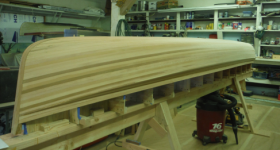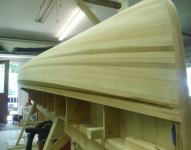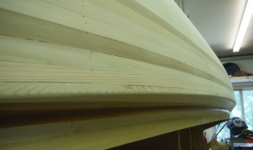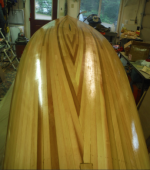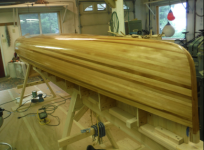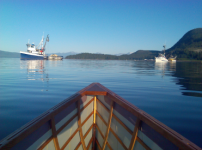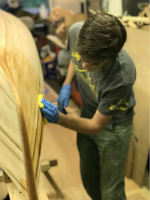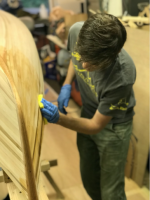I suppose I am looping the world in a bit late on this, and perhaps breaking a few etiquette rules in the process. If so, feel free to send along any necessary correctional criticism.
I am several months into my first cedar strip build - a John Winters Kite. My one previous build was a Platt Monfort SOF Snowshoe Lassie, which is great for an easy-going flat water jaunt, and for dragging through the woods. However, I wanted something a little more substantial for the bay in front of our home and the rivers out the road. I also enjoyed the first building process nearly as much as I enjoy paddling. Those factors, coupled with the need to keep myself busy on Juneau's many rainy days, motivated this second build. It will surely not be the last.
Please excuse the several faux pas you will notice early on: I made the (possibly royal) mistake of skimping on the strongback... I know, I know - stupid! Although it seems to have not warped or bent, I am sure I will regret that. The ripping and milling process was a bit of a learning experience for me, too. As such, the strips weren't as close to perfect as others. Finally, I am sure it was a bad call to hop on the canoe after fixing the last strip in place but I was pretty excited. No known damage form my enthusiasm.
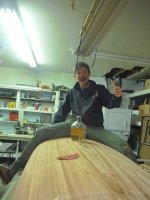
I have sanded the outside, added the fillet, and will hopefully be glassing this weekend or next. I figured this is a good point to start asking advice.
I am not extremely skilled at social media, etc, but will try to be consistent about sharing progress. I am not building very fast, though, since I am working and schooling full time.
I am several months into my first cedar strip build - a John Winters Kite. My one previous build was a Platt Monfort SOF Snowshoe Lassie, which is great for an easy-going flat water jaunt, and for dragging through the woods. However, I wanted something a little more substantial for the bay in front of our home and the rivers out the road. I also enjoyed the first building process nearly as much as I enjoy paddling. Those factors, coupled with the need to keep myself busy on Juneau's many rainy days, motivated this second build. It will surely not be the last.
Please excuse the several faux pas you will notice early on: I made the (possibly royal) mistake of skimping on the strongback... I know, I know - stupid! Although it seems to have not warped or bent, I am sure I will regret that. The ripping and milling process was a bit of a learning experience for me, too. As such, the strips weren't as close to perfect as others. Finally, I am sure it was a bad call to hop on the canoe after fixing the last strip in place but I was pretty excited. No known damage form my enthusiasm.

I have sanded the outside, added the fillet, and will hopefully be glassing this weekend or next. I figured this is a good point to start asking advice.
I am not extremely skilled at social media, etc, but will try to be consistent about sharing progress. I am not building very fast, though, since I am working and schooling full time.
Last edited:

